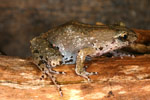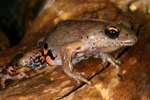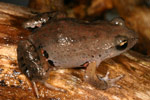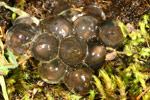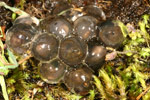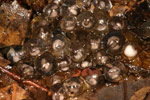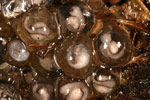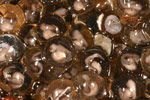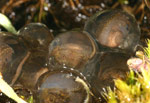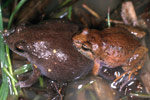Geocrinia victoriana
Victorian Smooth Froglet
Also: Eastern Smooth Froglet

+ 55 kb Victorian Smooth Froglet (Geocrinia victoriana)
A common and widespread but secretive species, this frog is most often encountered in late summer and autumn when inquisitive people go in search of the origin of its most distinctive call.
Distribution and habitat

Adults can be found in moist areas ranging from rainforests through wet and dry forests, woodlands, shrublands, grasslands, and even alpine bogs. Eggs are terrestrial, and spawned in moist leaf litter or in the bases of grass tussocks in areas that will later be flooded. Tadpoles are aquatic, in dams, flooded ditches, and ponds.
There is a detailed distribution map available for: Victoria.
Calling
Males call from the ground in moist leaf litter and among grass tussocks, usually near water in low areas which are later flooded. The call is a long harsh introductory note followed by a long series of short rapidly repeated explosive musical notes - "wa-a-a-a-a-ark pip-pip-pip-pip-pip-pip...".
Copyright Murray Littlejohn. Recorded by Murray Littlejohn. Must not be reproduced without permission.
Life cycle

Distinguishing characteristics
Adult
length: 20-35mm.
90 - 160 pigmented eggs are spawned, adhering in sticky clumps in leaf litter or grass tussocks. Tadpoles hatch when the area is flooded and are dark brown with clear fins flecked with brown. Adults have smooth bellies, sometimes a pink patch in each armpit or groin, and pink marbled with dark pigment on hind of thighs.
Visible features
Presented here is the information stored in the frogs.org.au database which is used to identify frogs based on their appearance. It is intended to be used in a key guide for separating species so some of the information (for example, back colours) may be rather non-specific. The system is currently being developed - if you notice errors in the data, please write to Dave Black at the address at the bottom of the page.
Important note: This information details only the appearance of the frog. If an "or" appears in the description, this may mean either that there is some variation within the species or that the feature might be observed differently by different people. For example, if a frog has very small toe pads, it may be listed as having "Toe pads: present or absent".
Size
Up to between 30mm and 60mm
Eyes, hands, and feet
Pupils: horizontal
Toe pads: absent
Webbing on feet: no webbing
Belly
Texture: smooth
Pattern: marbled or peppered
Colour: multi-coloured featuring a colour in addition to black, grey, and white
Back
Texture: smooth or rough or warty
Pattern: plain or mixed / marbled
Colour: single colour or multi-coloured
Glands and tubercles
Parotoid gland: absent
Tibial gland: absent
Metatarsal tubercles: absent
Similar species (note: this version was written for Victorian species).
Distinguished from most species by the pink colouring in the groin. May only be distinguished from Geocrinia laevis by call and by distribution.
Geocrinia victoriana image gallery
The scientific names of Geocrinia victoriana
- Crinia victoriana (Boulenger 1888)
- Crinia froggatti (Fletcher 1891)
- Geocrinia victoriana (Boulenger 1888)


